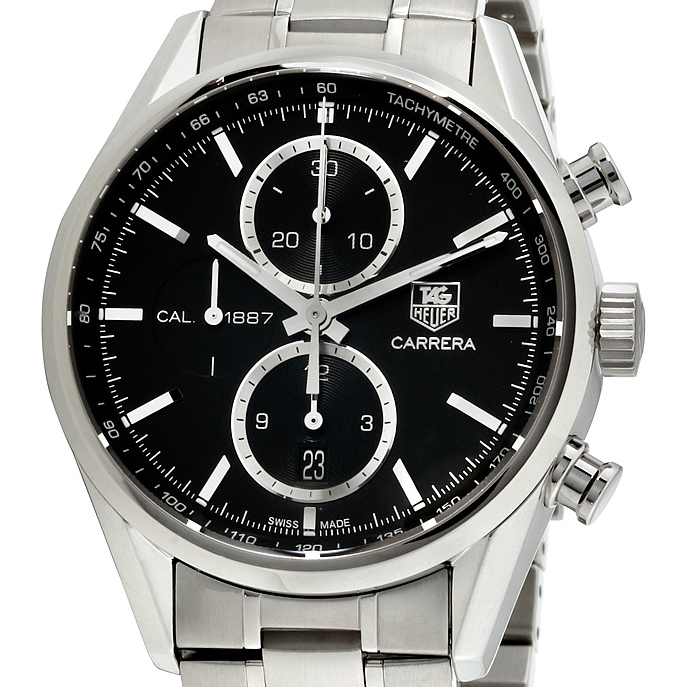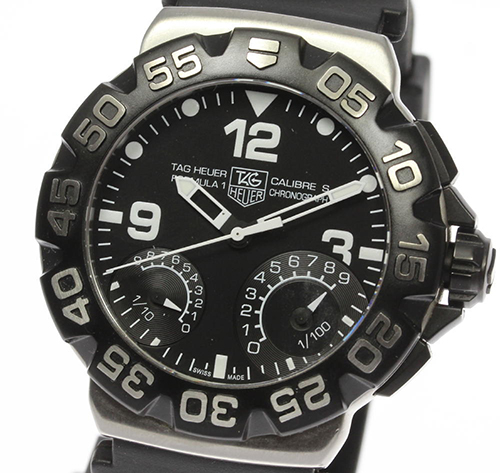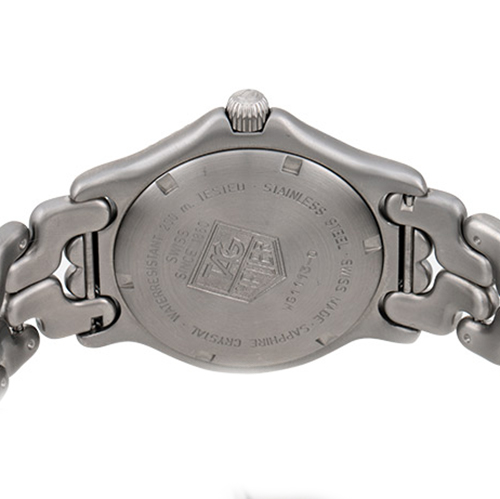How to Spot a Fake TAG Heuer Watch
TAG Heuer is attached to connotations of prestige brought by the horological advancements that the brand made as well as the association with glamorous and dangerous races and movie-star race car drivers. It’s an innovator in the field of horology, with such accolades as being the first to create a chronograph dashboard clock and incorporating a rotating bezel into the design of a watch. This so clearly demonstrates why TAG Heuer watches are often replicated on the black market. To protect yourself from falling for a fake TAG Heuer watch scam, follow this guide we’ve put together to distinguishing a real TAG Heuer from a counterfeit.
The Dial
Though TAG Heuer watches tend to run at a much more affordable price point than, say, a Rolex or an Omega, the brand never sacrifices the quality of its products for cheap production. The dial is always very telling when it comes to sussing out a counterfeit watch, and because the dials on TAG Heuer watches are made to fit the brand’s exacting specifications, even the slightest mistake will be a clear giveaway to the timepiece’s artifice.
The Face
Like all luxury watches, TAG Heuer models have sapphire crystal guarding the face of the watch. This material is scratch-resistant and incredibly refined. To test whether the material on the face of your watch is sapphire crystal or just plain old glass, smear a drop of water or two on the surface. Sapphire crystal should not disturb the water’s surface tension, so it should pool together on the crystal. On glass, however, the water would disperse unevenly.

On the actual face of the watch, you should first and foremost find the phrase “Swiss Made” at the 6 o’clock marker. Some counterfeits have “Japanese Movement” across that marker, which would never appear on a TAG Heuer, or even nothing at all.
In addition to that, make sure that the TAG Heuer logo is cleanly cut and pressed into the steel of the dial, not glued on. If you find glue residue or uneven edges on the logo, then you know that you have a counterfeit on your hands.
The Lumes
TAG Heuer uses LumiNova technology, which ensures that the lumes are incredibly bright and sharp in the dark. If your watch does not glow brilliantly in the dark, even after it’s been charged in the light, then it doesn’t have the LumiNova technology and is, therefore, a fake.
The Date Complication
Almost all TAG Heuer models have a date complication, but only some have a day-date complication. Namely, the Calibre 5 and Calibre 16 models in the TAG Heuer Carrera collection will have both the day and the date displays. It pays to make sure that you know exactly what comes with an original version of the model you’re eyeing because this can expose a watch for a counterfeit if you find a model that supposedly has more displays than it’s supposed to.
Of course, in addition to that, it pays to make sure that the numbers and letters are perfectly centered in their display windows. A poorly-made counterfeit might have crooked numbers or ones that aren’t placed properly.

TAG Heuer Formula 1 SubDials
The Subdials
On watches like the TAG Heuer Carrera or the Formula 1, which are renowned for their impeccably precise chronograph function, it is especially important to test out the subdials to make sure that they are operational. First of all, each subdial must have a different set of numbers that it uses to measure time, as each one has a different purpose. Secondly, each chronograph subdial must have a pusher that corresponds to it, so play around with the pushers above and below the crown of the watch to make sure that both the subdials and the pushers are all functional.
The Case
The Bezel
TAG Heuer was one of the first watchmakers to outfit their timepieces with a rotating tachymeter bezel so that drivers who use TAG Heuer watches may time themselves and gauge how far they’ve gone just by glancing at their watch. As such, the rotating bezel on a real TAG Heuer watch should be impeccably designed. Test this out by rotating it on the watch you’re looking it: an authentic watch should rotate easily and should be accompanied by the correct number of clicks. A forged TAG Heuer’s bezel might not turn as easily or click correctly.
The Crown
The same test should be conducted on the crown. Authentic TAG Heuer watches have a remarkable winding mechanism that makes it nearly effortless to wind the watch: the movement is so smooth and easy that some say it hardly even feels like you’re winding the watch at all! On a counterfeit watch, naturally, you would feel the shifting of the watch’s movement inside and experience some resistance. Depending on how difficult it is to wind the watch, it might even be indicative of a damaged or at least cheaply-made watch movement.

In addition to the functional aspect of the crown, it is also imperative to examine the aesthetic aspect of it. The TAG Heuer logo on the crown should be embossed into the steel. It should not be a separate piece of metal pressed into the steel and certainly not glued onto the steel like it would be on a counterfeit.
The Caseback
Unlike Rolex, TAG Heuer’s casebacks are not uniform, so their design differs based on the model you’re looking at. One thing that they all have in common, however, is that somewhere on the caseback you will find engraved the following: the watch’s model number, its unique serial number, and its water resistance. All TAG Heuer watches are water resistant to at least 100 meters, so a watch that says it’s resistant to less than 100m (barring the brand’s authentic smartwatches, of course) is not an authentic TAG Heuer.

On a metal caseback, the model number, serial number, and water resistance will also be accompanied by a high-quality laser engraving of the TAG Heuer logo. On a crystal caseback, the watch’s information will be engraved on the rim around the sides of the crystal.
When checking a watch’s authenticity, it is also helpful to double check the model and serial numbers on the watch. This chart will allow you to cross-reference the model number on the watch you’re looking at with the official model number codes that the brand uses so that you can authenticate your watch. You could also call on your local TAG Heuer retailer to look up the watch’s serial number for you.
The Bracelet
TAG Heuer’s bracelets, like the rest of the watch, are impeccably made. As such, you can expect them to be expertly crafted, with high-quality parts. Counterfeiters often won’t take the time to make this part of the watch accurate to the brand’s specifications, so pay attention to this, as well. Every single part of each link should be made with separate, high-quality pieces of metal.

This is especially important to remember when it comes to the TAG Heuer Link collection. These watches are fitted with unique “S-shaped” bracelets that are made with separate pieces of metal made to fit together perfectly. Instead of using separate pieces of metal, forgers will often just etch a line in the middle of each link to make it look like they’re separate, but they really aren’t. This is a significant clue to a counterfeit watch, so examine the bracelet carefully if you’re thinking about purchasing a watch that may look like a TAG Heuer Link.
The Papers
Though a box and papers of certification usually mean that a watch is authentic, even these can be forged or faked. One way to tell whether a TAG Heuer watch’s certification is real is to look for the embossed holographic seal on the document. It should also carry the unique serial number that matches the one engraved on the watch’s caseback. This serial number should also be able to be cross-referenced with TAG Heuer’s records to authenticate the watch.
If you are still uncertain about the authenticity of your watch, we recommend that you take it to a professional watchmaker who can open the caseback and, by examining the watch’s movement, should be able to verify the authenticity of the timepiece. And if you have any other questions, TrueFacet’s support team is here to help! Find their contact information here.







